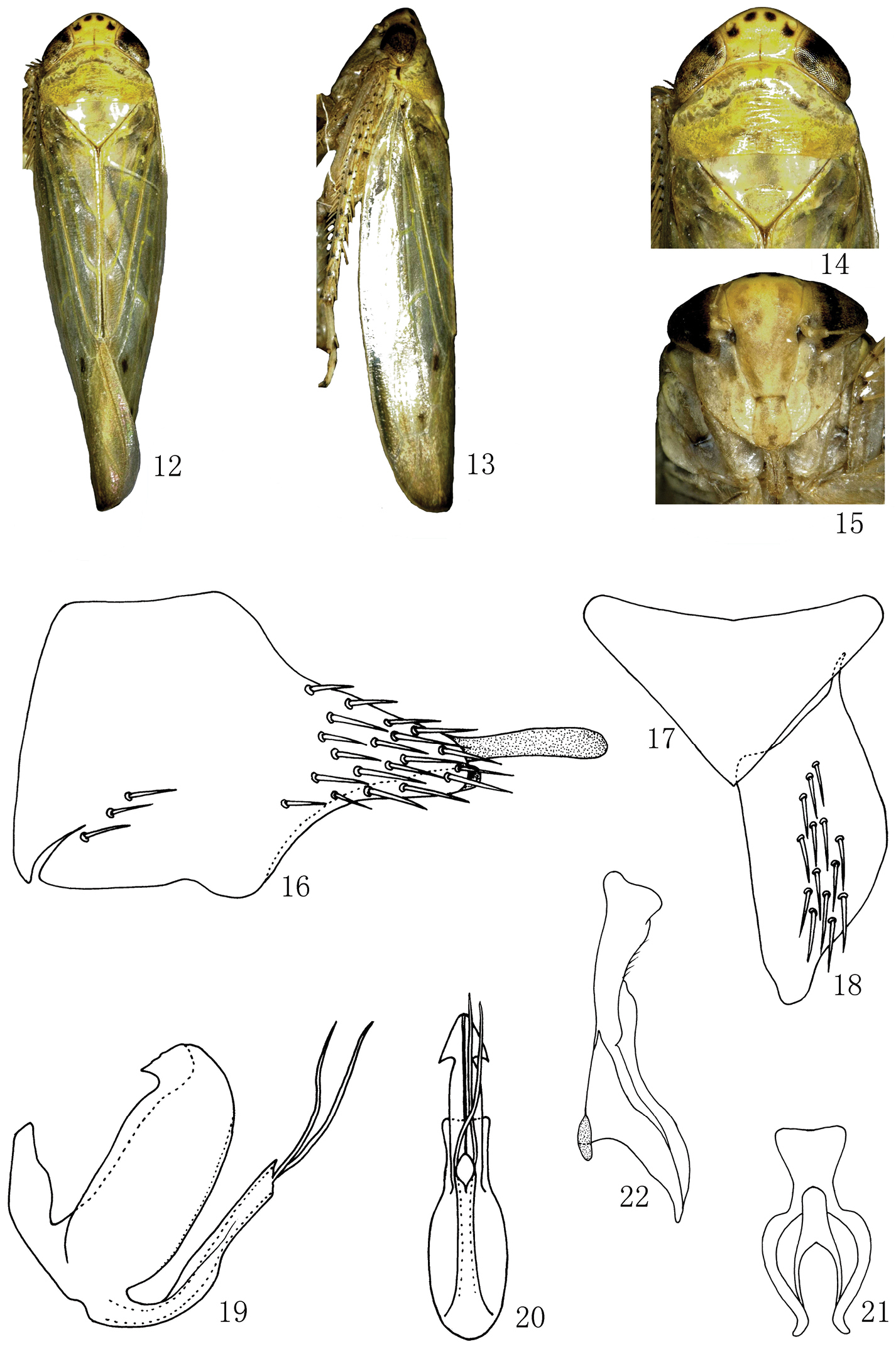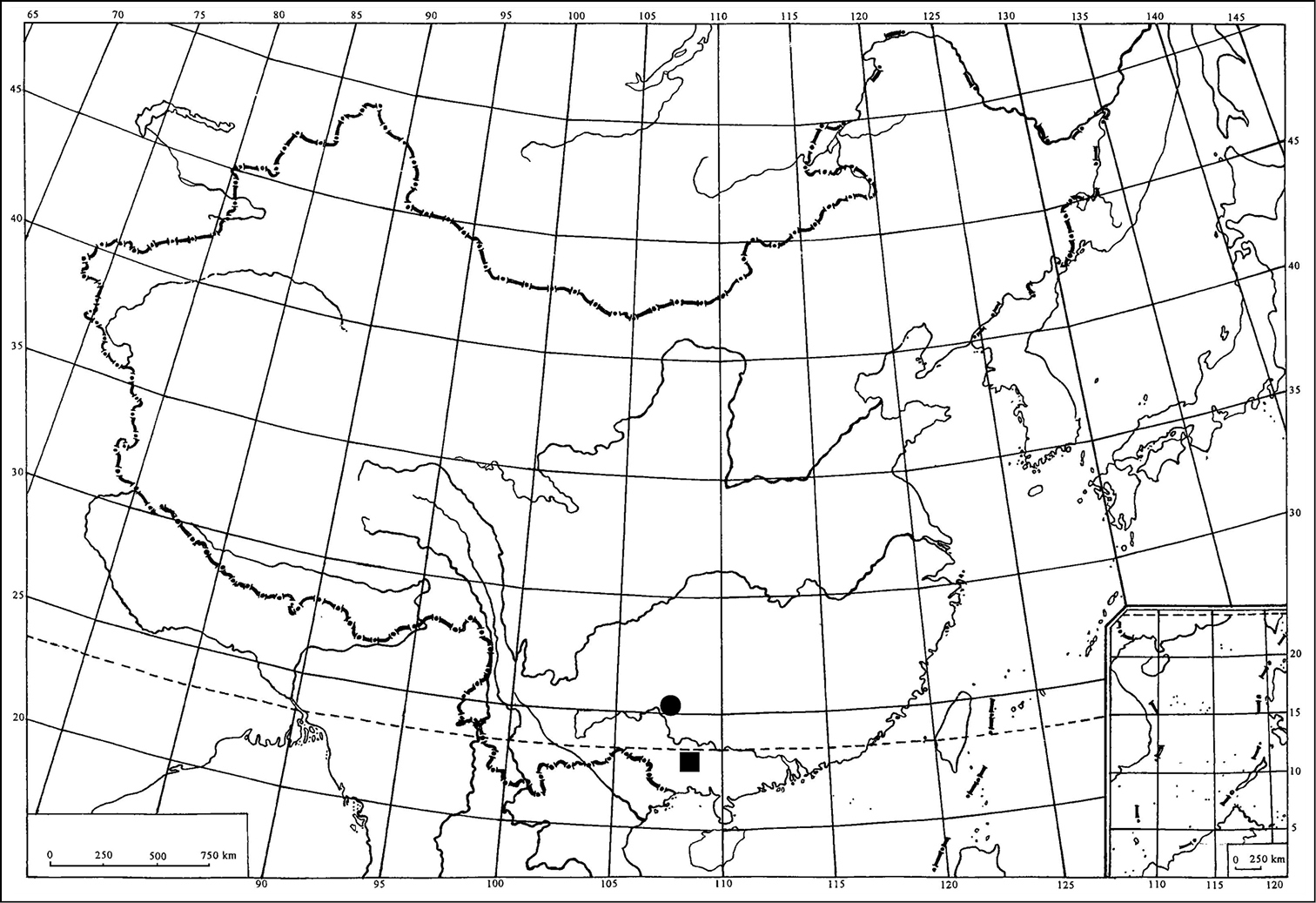






Citation: Xing J, Li Z (2014) Two new species of the genus Abrus Dai & Zhang, 2002 (Hemiptera, Cicadellidae, Deltocephalinae) from China. ZooKeys 419: 103–109. doi: 10.3897/zookeys.419.7481
Two new species of leafhoppers: Abrus damingshanensis sp. n. (from Guangxi) and A. expansivus sp. n. (from Guizhou) are described and illustrated from China. A map showing the geographic distribution of the two new species is given. Taxonomic notes on species of the genus Abrus is also provided.
Homoptera, leafhopper, morphology, taxonomy, distribution
The genus Abrus belonging to the tribe Athysanini of subfamily Deltocephalinae, was established by
This genus is distinguished by its crown with two pairs of similar black spots on anterior margin, clypellus expanded apically, male pygophore with a long membranous process from its inner apex, and aedeagus with a well-developed basal projection dorsally (except Abrus breviolus and Abrus langshanensis).
In the present paper, two new species: Abrus damingshanensis sp. n. and Abrus expansivus sp. n. are described and illustrated from China (Oriental Region, Fig. 23). The type specimens of the new species are deposited in the Institute of Entomology, Guizhou University, Guiyang, China (GUGC).
Terminology of morphological and genital characters follow
http://zoobank.org/211F15BE-9FD5-4A84-9D74-E3A16BA498DD
Figs 1–11Yellowish brown species. Crown with two pairs of similar blackish brown spots on anterior margin. Eyes brown. Ocelli pale yellow. Pronotum with yellowish-brown stripe on anterior part. Inner and central anteapical cells at apex, third and fourth apical cells at base each with a dark brown spot. Face brown, frontoclypeus yellowish brown. Forewings yellowish. Legs marked with brown.
Body elongate, robust. Head including eyes narrower than greatest width of pronotum. Vertex with fore margin produced roundly, median length shorter than width between eyes. Eyes fairly large. Ocelli on anterior margin, separated from corresponding eye by approximately their own diameter. Frontoclypeus distinctly longer than wide, anteclypeus expanded apically. Antennae arising near lower corner of eye. Pronotum with anterior margin strongly and roundly produced, posterior margin slightly concave. Scutellum triangular, slightly shorter than pronotum, with transverse suture curved and depressed. Forewing with 3 subapical and 4 apical cells, 4 times as long as wide, appendix wide. Hind wings with three apical cells and two anteapical cells. Profemur with 2 dorsoapical setae. Hind femur apical setal formula 2+2+1. Hind tibia flattened and nearly straight, with PD setae very long. Metabasitarsomere with three platellae and two setae on apical transverse row.
Male genitalia. Male pygofer side longer than high, with many macrosetae posteriorly and some at midventral margin; posterior margin lobe alongate and with a long membranous process at inner apex (Fig. 5). Valve subtriangular with anterior margin concaved and posterior margin strongly produced medially (Fig. 6). Subgenital plate narrowing to rounded apex, outer margin rounded, with uniseriate row of macrosetae along lateral margin (Fig. 7). Aedeagus with well-developed basal projection on dorsal margin, tapered to acute apex, with pair of dorsal quadrilateral flange at midlength on dorsal margin; aedeagal shaft about half length of basal projection, expanded medially, apically branched in the caudal view, gonopore apical (Figs 8, 9). Connective Y–shaped, stem robust, arms well developed, articulated with the aedeagus (Fig. 10). Style long, broad at base, narrow at middle, apical margin expanded (Fig. 11).
Abrus damingshanensis sp. n., 1 ♂, dorsal view 2 ♂, lateral view 3 ♂, head and thorax, dorsal view 4 ♂, face 5 Male pygofer side, lateral view 6 Valve, ventral view 7 Subgenital plate, ventral view 8 Aedeagus, lateral view 9 Aedeagus, caudal view 10 Connective, ventral view 11 Style, dorsal view.
Length (including tegmen): ♂, 9.1–9.2 mm.
Holotype ♂, China: Guangxi Autonomous Region, Nanning City, Mt. Damingshan, 13 August 2011, coll. Zaihua Yang (GUGC); paratypes 2♂♂, same data as holotype (GUGC).
Thenew species is similar to Abrus leigongshanensis Li & Wang, 2006, but can be distinguished from the latter by the aedeagal shaft broad and short (about half length of basal projection); the basal projection tapered to acute apex, with pair of quadrilateral flange at midlength; and the apical process of style expanded.
This new species is named after the type locality, Damingshan, Guangxi Autonomous Region in China.
http://zoobank.org/9C25F88C-D706-481F-B6B1-089C0EE2D4D8
Figs 12–22External features resemble as Abrus damingshanensis sp. n., but color light yellow and body slightly small.
Male genitalia. Male pygofer side elongate with many macrosetae posteriorly and a few at midventral margin; posterior margin lobe elongate and with a long membranous process at inner apex (Fig. 16). Valve subtriangular with anterior margin concaved and posterior margin strongly produced medially (Fig. 17). Subgenital plate broad and short, outer margin rounded, with many macrosetae on lateral margin (Fig. 18). Aedeagus with broad and flat basal projection from dorsal margin, deeply concave at dorsal margin, the basal projection without processes; aedeagal shaft slightly shorter than basal projection, with a pair of slender apical processes and its length equal to aedeagal shaft, gonopore apical (Figs 19, 20). Connective Y–shaped, stem robust, arms well developed, articulated with the aedeagus (Fig. 21). Style long, broad at base, narrow at middle, apex slightly widening (Fig. 22).
Abrus expansivus sp. n., 12 ♂, dorsal view 13 ♂, lateral view 14 ♂, head and thorax, dorsal view 15 ♂, face 16 Male pygofer side, lateral view 17 Valve, ventral view 18 Subgenital plate, ventral view 19 Aedeagus, lateral view 20 Aedeagus, caudal view 21 Connective, ventral view 22 Style, dorsal view.
Length (including tegmen): ♂, 8.1 mm.
Holotype ♂, China: Guizhou Province, Dushan County, 16 July 2012, coll. Qiongzhang Song (GUGC).
This new species is very similar to Abrus brevis Dai & Zhang, 2002 in aedeagal shaft with a pair of long apical appendages, but can be distinguished from the latter by the aedeagal shaft longer than half length of basal projection; aedeagal shaft with apical processes located medially in lateral view and its length equal to aedeagal shaft; the apical process of style wide and flat; and the subgenital plate narrow apically.
The new species name is derived from the Latin word “expansivus”, referring to the apical process of style wide and expand.
Species of Abrus are all very similar in coloration and difficult to distinguish externally, but the structure of aedeagus are markedly different. This genus now contains 19 species, them can be divided into 3 types based on the structure of aedeagus: 1) basal projection of aedeagus very small or absent (Abrus breviolus and Abrus langshanensis); 2) aedeagal shaft obviously shorter than basal projection (Abrus brevis, Abrus leigongshanensis, Abrus damingshanensis sp. n. and Abrus expansivus sp. n.); 3) aedeagal shaft as long as or longer than basal projection (other 13 species).
Above mentioned the second type structure of aedeagus, of them, two species (Abrus brevis and Abrus damingshanensis sp. n.) with aedeagal shaft about half length of basal projection, two species (Abrus brevis and Abrus expansivus sp. n.) with aedeagal shaft apically have a pair of slender processes, and two species (Abrus damingshanensis sp. n. and Abrus expansivus sp. n.) with the apical process of style expand.
Geographic distribution of two new Abrus species in China: Abrus damingshanensis sp. n. (■); Abrus expansivus sp. n. (●).
We are grateful to Dr. Yang Zaihua and Ms. Song Qiongzhang for collecting specimens, and also grateful to two anonymous referees for reading the manuscript and making some suggestions. This work was supported by China Postdoctoral Science Foundation funded project (2013T60864, 2012M521719) and the National Natural Science Foundation of China (31301909).


